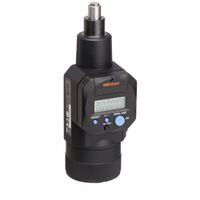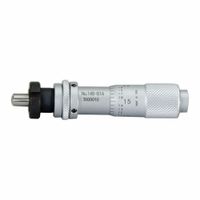Call +(254) 703 030 000 / 751 483 999 / 721 704 777
- Home
- Machining
- Precision Measuring Tools
- Micrometers Depth Gauges Accessories
- Micrometer Heads
.....Read More
Frequently Asked Questions
What is a micrometer head used for?
A micrometer head is a precision instrument used for measuring small distances or thicknesses with high accuracy. It is a critical component in various applications across industries such as manufacturing, engineering, and scientific research. The micrometer head consists of a spindle, thimble, and anvil, which work together to provide precise measurements.
The primary function of a micrometer head is to measure linear dimensions, typically in the range of micrometers (one-millionth of a meter) or thousandths of an inch. It is commonly used in machining and mechanical engineering to ensure that components meet specified tolerances. The micrometer head allows for fine adjustments and readings, often with a resolution of 0.01 mm or 0.001 inches, depending on the design.
In practice, the micrometer head is used by placing the object to be measured between the spindle and the anvil. The thimble is then rotated, moving the spindle towards the anvil until the object is gently secured. The measurement is read from the scale on the thimble and sleeve, which provides a direct reading of the object's size.
Micrometer heads are also used in laboratory settings for precise measurements in experiments and research. They are essential in quality control processes, where they help verify the dimensions of parts and materials, ensuring they conform to design specifications.
Overall, the micrometer head is a vital tool for achieving high precision in measurement tasks, contributing to the accuracy and quality of manufactured products and scientific research outcomes.
How do you read a micrometer head?
To read a micrometer head, follow these steps:
1. **Identify the Parts**: A micrometer consists of a frame, anvil, spindle, sleeve (barrel), thimble, and ratchet stop.
2. **Zero Check**: Ensure the micrometer is calibrated by closing the spindle to the anvil. The zero on the thimble should align with the reference line on the sleeve. If not, recalibrate.
3. **Read the Sleeve**: The sleeve has a linear scale marked in millimeters or inches. Each increment typically represents 1mm or 0.025 inches. Note the last visible whole number on the sleeve.
4. **Read the Thimble**: The thimble rotates around the sleeve and is marked with 50 or 25 divisions, depending on the micrometer's resolution. Each division usually represents 0.01mm or 0.001 inches. Note the number on the thimble that aligns with the sleeve's reference line.
5. **Combine Readings**: Add the sleeve reading to the thimble reading. For example, if the sleeve reads 5mm and the thimble reads 0.28mm, the total measurement is 5.28mm.
6. **Vernier Scale (if present)**: Some micrometers have a vernier scale for additional precision. Align the vernier scale with the thimble scale to find the exact fraction of the smallest division. Add this to the combined reading.
7. **Final Measurement**: Sum the sleeve, thimble, and vernier readings for the final measurement.
8. **Use Ratchet Stop**: Always use the ratchet stop to ensure consistent pressure and avoid over-tightening, which can lead to inaccurate readings.
By following these steps, you can accurately read a micrometer head and obtain precise measurements.
What are the different types of micrometer heads?
There are several types of micrometer heads, each designed for specific applications and precision measurement needs:
1. **Standard Micrometer Head**: This is the most common type, featuring a spindle and thimble for general measurement tasks. It is used in various applications where precise linear measurements are required.
2. **Digital Micrometer Head**: Equipped with an electronic display, this type provides digital readouts for enhanced accuracy and ease of reading. It often includes features like data output for recording measurements.
3. **Vernier Micrometer Head**: This type includes a vernier scale for increased precision, allowing for measurements to be read to a finer resolution than standard micrometer heads.
4. **Depth Micrometer Head**: Specifically designed for measuring depths, this type features a flat base and a spindle that extends downward to measure the depth of holes or recesses.
5. **Screw Thread Micrometer Head**: Used for measuring the pitch diameter of screw threads, this type has a specialized anvil and spindle designed to fit into the thread grooves.
6. **Blade Micrometer Head**: This type features a blade-like anvil and spindle, ideal for measuring narrow grooves or slots where standard micrometer heads cannot fit.
7. **Spherical Micrometer Head**: Equipped with spherical anvils, this type is used for measuring curved surfaces or spherical objects.
8. **Interchangeable Anvil Micrometer Head**: This versatile type allows for different anvils to be attached, making it suitable for a variety of measurement tasks.
9. **High-Precision Micrometer Head**: Designed for applications requiring extremely high accuracy, these heads often have finer graduations and more precise mechanisms.
10. **Non-Rotating Spindle Micrometer Head**: This type prevents the spindle from rotating during measurement, reducing the risk of damaging delicate surfaces.
Each type of micrometer head is tailored to specific measurement needs, ensuring precision and reliability in various industrial and laboratory settings.
How accurate are micrometer heads?
Micrometer heads are highly accurate measuring instruments used for precise measurements, typically in mechanical engineering and machining. Their accuracy is generally within the range of ±0.0001 inches (±0.00254 mm) for standard models, although this can vary based on the specific design and quality of the micrometer. High-precision micrometer heads can achieve even greater accuracy, sometimes reaching ±0.00005 inches (±0.00127 mm).
The accuracy of a micrometer head is influenced by several factors:
1. **Build Quality**: High-quality materials and precise manufacturing processes contribute to the accuracy. The spindle and anvil must be perfectly parallel and the screw thread must be finely machined.
2. **Calibration**: Regular calibration against a standard gauge block is essential to maintain accuracy. Calibration ensures that any wear or mechanical drift is corrected.
3. **Environmental Conditions**: Temperature fluctuations can affect measurements. Micrometers are often used in controlled environments to minimize thermal expansion or contraction of the materials being measured.
4. **User Technique**: Proper handling and consistent application of measuring force are crucial. Many micrometers include a ratchet or friction thimble to ensure consistent pressure.
5. **Wear and Tear**: Over time, mechanical components can wear down, affecting accuracy. Regular maintenance and careful use can mitigate this.
6. **Resolution**: The smallest increment a micrometer can measure, typically 0.001 mm or 0.0001 inches, also defines its precision.
In summary, micrometer heads are extremely accurate tools when properly maintained and used under appropriate conditions. Their precision makes them indispensable in fields requiring exact measurements, such as manufacturing and quality control.
How do you calibrate a micrometer head?
To calibrate a micrometer head, follow these steps:
1. **Clean the Micrometer**: Ensure the micrometer is clean and free from dust or debris. Use a soft cloth to wipe the surfaces.
2. **Check Zero Setting**: Close the micrometer by turning the thimble until the spindle contacts the anvil. The reading should be zero. If not, adjust the sleeve by loosening the lock nut and rotating the sleeve until the zero aligns with the index line.
3. **Use a Calibration Standard**: Obtain a set of gauge blocks or a calibration standard with known dimensions. These should be traceable to a national standard for accuracy.
4. **Measure the Standard**: Place the gauge block between the spindle and anvil. Gently turn the thimble until the spindle contacts the block. Use the ratchet stop or friction thimble to ensure consistent pressure.
5. **Read the Measurement**: Note the reading on the micrometer. It should match the known dimension of the gauge block.
6. **Adjust if Necessary**: If the reading does not match, adjust the micrometer. Loosen the lock nut and rotate the sleeve to correct the reading. Tighten the lock nut once the correct reading is achieved.
7. **Repeat for Different Sizes**: Use different gauge blocks to check the micrometer across its range. This ensures accuracy at various points.
8. **Document the Calibration**: Record the results, including any adjustments made, the date, and the person performing the calibration.
9. **Regular Calibration**: Establish a regular calibration schedule based on usage frequency and precision requirements.
10. **Environmental Considerations**: Perform calibration in a controlled environment to minimize temperature and humidity effects.
By following these steps, you ensure the micrometer head provides accurate and reliable measurements.
What is the difference between a micrometer head and a micrometer screw gauge?
A micrometer head and a micrometer screw gauge are both precision measurement tools, but they serve slightly different purposes and have distinct features.
1. **Micrometer Head**:
- **Purpose**: Primarily used as a component in other measuring instruments or machinery for precise adjustments.
- **Design**: Consists of a spindle, thimble, and a graduated scale, but lacks a frame or anvil.
- **Usage**: Often integrated into devices like optical instruments, stages of microscopes, or any equipment requiring fine positional adjustments.
- **Measurement**: Provides linear displacement readings, typically in millimeters or inches, based on the rotation of the thimble.
- **Flexibility**: Can be customized or adapted for specific applications, offering versatility in design and integration.
2. **Micrometer Screw Gauge**:
- **Purpose**: Used as a standalone tool for measuring the external dimensions of objects, such as thickness or diameter.
- **Design**: Comprises a C-shaped frame, anvil, spindle, thimble, and a ratchet stop for consistent pressure.
- **Usage**: Commonly used in mechanical engineering, metalworking, and machining for direct measurement tasks.
- **Measurement**: Provides highly accurate readings, typically to the nearest 0.01 mm or 0.001 inches, with a vernier scale for enhanced precision.
- **Portability**: Designed for handheld use, making it convenient for on-site measurements.
In summary, while both tools utilize a screw mechanism for precision measurement, the micrometer head is a component for integration into other systems, whereas the micrometer screw gauge is a complete, portable tool for direct measurement tasks.
How do you maintain a micrometer head?
To maintain a micrometer head, follow these steps:
1. **Cleaning**: Regularly clean the micrometer head to remove dust, dirt, and debris. Use a soft, lint-free cloth or a brush to gently wipe the surfaces. Avoid using compressed air as it can force debris into the mechanism.
2. **Lubrication**: Apply a small amount of high-quality instrument oil to the spindle and thimble threads. This ensures smooth operation and prevents rust. Avoid over-lubrication as it can attract dust.
3. **Calibration**: Periodically check the calibration of the micrometer head using gauge blocks or a calibration standard. Adjust as necessary to ensure accurate measurements.
4. **Storage**: Store the micrometer in a protective case when not in use. Keep it in a dry, temperature-controlled environment to prevent corrosion and thermal expansion.
5. **Handling**: Handle the micrometer with care. Avoid dropping or applying excessive force, which can damage the precision components.
6. **Inspection**: Regularly inspect the micrometer for signs of wear or damage. Check for smooth movement of the spindle and thimble, and ensure the locking mechanism functions properly.
7. **Avoid Contamination**: Keep the micrometer away from chemicals, moisture, and extreme temperatures. These can damage the materials and affect accuracy.
8. **Use Properly**: Always use the micrometer for its intended purpose. Avoid using it as a clamp or for measuring objects beyond its capacity.
By following these maintenance practices, you can ensure the longevity and accuracy of your micrometer head.

